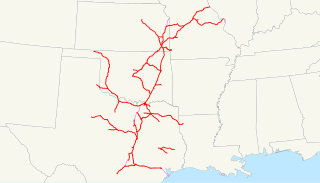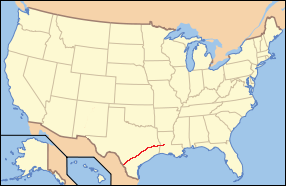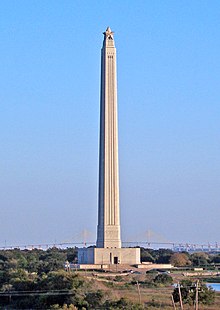
Kendall County is a county located on the Edwards Plateau in the U.S. state of Texas. In 2020 census, its population was 44,279. Its county seat is Boerne. The county is named for George Wilkins Kendall, a journalist and Mexican–American War correspondent.

The Missouri–Kansas–Texas Railroad was a Class I railroad company in the United States, with its last headquarters in Dallas, Texas. Established in 1865 under the name Union Pacific Railroad (UP), Southern Branch, it came to serve an extensive rail network in Texas, Oklahoma, Kansas, and Missouri. In 1988, it merged with the Missouri Pacific Railroad; today, it is part of UP.

The Old San Antonio Road was a historic roadway located in the U.S. states of Texas and Louisiana. Parts of it were based on traditional Native American trails. Its Texas terminus was about 35 miles (56 km) southeast of Eagle Pass at the Rio Grande in Maverick County, and its northern terminus was at Natchitoches, Louisiana. The road continued from Texas through Monclova to Mexico City.

The Chisholm Trail was a trail used in the post-Civil War era to drive cattle overland from ranches in southern Texas, crossed the Red River into Indian Territory, and ended at Kansas rail stops. The trail encompassed a pathway established by Black Beaver in 1861, and a wagon road established by Jesse Chisholm around 1864. "The Chisholm Wagon Road went from Chisholm's trading post on the South Canadian (north of Fort Arbuckle to the Cimarron River crossing, to the Arkansas River at the future site of Wichita where Chisholm had another trading post and on north to Abilene," according to the Kraisingers. By 1869, the entire trail from Texas to Kansas became known as the Chisholm Trail.

The Tower of the Americas is a 750-foot (229-meter) observation tower-restaurant located in the Hemisfair district in the southeastern portion of Downtown San Antonio, Texas, United States. The tower was designed by San Antonio architect O'Neil Ford and was built as the theme structure of the 1968 World's Fair, HemisFair '68. Originally known as 'HemisFair Tower', it was ultimately named 'the Tower of the Americas' as a result of a name-the-tower contest created by the executive committee. Sixty-eight people submitted the name by which the tower is now known.

The San Antonio River Walk is a city park and special-case pedestrian street in San Antonio, Texas, one level down from the automobile street. The River Walk winds and loops under bridges as two parallel sidewalks lined with restaurants and shops, connecting the major tourist draws such as the Shops at Rivercenter, the Arneson River Theatre, Marriage Island, La Villita, HemisFair Park, the Tower Life Building, the San Antonio Museum of Art, the Pearl, and the city's five Spanish colonial missions, which have been named a World Heritage Site, which includes the Alamo. During the annual springtime Fiesta San Antonio, the River Parade features flowery floats that float down the river.

San Antonio Missions National Historical Park is a National Historical Park and part of a UNESCO World Heritage Site preserving four of the five Spanish frontier missions in San Antonio, Texas, USA. These outposts were established by Catholic religious orders to spread Christianity among the local natives. These missions formed part of a colonization system that stretched across the Spanish Southwest in the 17th, 18th, and 19th centuries.

The Texas Historical Commission is an agency dedicated to historic preservation within the U.S. state of Texas. It administers the National Register of Historic Places for sites in Texas.
The Texas Brazos Trail is a non-profit organization which promotes heritage tourism, economic development, and historic preservation. It is one of ten regions which make up the Texas Heritage Trails Program of the Texas Historical Commission.

El Camino Real de Tierra Adentro, also known as the Silver Route, was a Spanish 2,560-kilometre-long (1,590 mi) road between Mexico City and San Juan Pueblo, New Mexico, that was used from 1598 to 1882. It was the northernmost of the four major "royal roads" that linked Mexico City to its major tributaries during and after the Spanish colonial era.

The culture of Texas is very diverse, influenced by tremendous waves of migration out of the American North and West, in contrast to its eastern neighbors in the Deep South. It includes the regionalisms and distinct cultural identities of German Texan, Tejanos, Cajuns, Irish, African American, and White Southern enclaves established before the republic era and admission to statehood.

The culture of San Antonio reflects the history and culture of one of the state's oldest and largest cities straddling the regional and cultural divide between South and Central Texas. Historically, San Antonio culture comes from a blend of Central Texas and South Texas (Southwestern) culture. Founded as a Spanish outpost and the first civil settlement in Texas, San Antonio is heavily influenced by Mexican American culture due to Texas formerly being part of Mexico and, previously, the Spanish Empire. The city also has significant German, Anglo, and African American cultural influences. San Antonio offers a host of cultural institutions, events, restaurants and nightlife in South Texas for both residents and visitors alike.

The El Camino Real de los Tejas National Historic Trail is a national historic trail covering the U.S. section of El Camino Real de Los Tejas, a thoroughfare from the 18th-century Spanish colonial era in Spanish Texas, instrumental in the settlement, development, and history of Texas. The National Park Service designated El Camino Real de los Tejas National Historic Trail as a unit in the National Trails System in 2004.

The City of San Antonio is one of the oldest Spanish settlements in Texas and was, for decades, its largest city. Before Spanish colonization, the site was occupied for thousands of years by varying cultures of indigenous peoples. The historic Payaya Indians were likely those who encountered the first Europeans.
The Texas Forts Trail is a nonprofit organization chartered in 1999 which promotes heritage tourism, economic development, and historic preservation. It is one of 10 driving trail regions which make up the award-winning Texas Heritage Trails Program of the Texas Historical Commission. The driving trail is 650 miles (1,050 km) long.
The Texas Forest Trail is a non-profit organization which promotes heritage tourism, economic development, and historic preservation. The organization is one of ten driving trail regions which make up the award-winning Heritage Trails Program of the Texas Historical Commission.
The Texas Hill Country Trail is a non-profit organization which promotes heritage tourism, economic development, and historic preservation. It is one of ten regions which make up the Texas Heritage Trails Program of the Texas Historical Commission.
The Texas Lakes Trail is a non-profit organization which promotes heritage tourism, economic development, and historic preservation. It is one of ten regions which make up the Texas Heritage Trails Program of the Texas Historical Commission.

The Texas Plains Trail is a nonprofit organization which promotes heritage tourism, economic development, and historic preservation in a 52 county region in the Texas Panhandle and Texas South Plains. The headquarters of the organization is in Lubbock, Texas. Founded as part of John Connally's 1968 initiative to boost tourism in the state during HemisFair '68, the Texas Plains Trail is one of 10 travel trails that cover the entire state. Originally designed as a driving tour that encompassed more than 580 miles via designated roads adorned with iconic blue highway signs, the trail was reestablished as a nonprofit organization in 2003 as part of the broader Texas Heritage Trails Program and their efforts to stimulate economic growth by boosting tourism and historic preservation throughout Texas.














